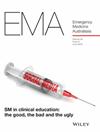What Proportion of Emergency Department Headache Patients With Normal Neurology Have a Serious Secondary Headache Cause? A HEAD Study Report
IF 1.4
4区 医学
Q2 EMERGENCY MEDICINE
引用次数: 0
Abstract
Objectives
To estimate the proportion of Emergency Department (ED) headache patients without neurological features who are diagnosed with a serious secondary headache cause.
Methods
Unplanned secondary analysis of HEAD Study/HEAD Colombia data. Patients without a known history of cerebral conditions and with a normal neurological assessment were included. The outcome of interest was the proportion of patients diagnosed with a serious secondary headache cause.
Results
One hundred ninety-one patients were diagnosed with a serious secondary headache cause (191/3951, 4.8%, 95% CI 4.2%–5.5%).
Conclusion
Absence of neurological features alone cannot be used to reliably exclude a serious secondary headache cause in ED patients.

神经功能正常的急诊科头痛患者继发严重头痛的比例是多少?校长研究报告
目的评估急诊科(ED)无神经学特征的头痛患者诊断为严重继发性头痛的比例。方法对HEAD研究/HEAD哥伦比亚数据进行非计划的二次分析。患者没有已知的大脑病史和正常的神经系统评估。我们感兴趣的结果是诊断为严重继发性头痛原因的患者比例。结果191例患者诊断为严重继发性头痛原因(191/3951,4.8%,95% CI 4.2% ~ 5.5%)。结论单纯缺乏神经学特征不能可靠地排除ED患者严重继发性头痛的原因。
本文章由计算机程序翻译,如有差异,请以英文原文为准。
求助全文
约1分钟内获得全文
求助全文
来源期刊

Emergency Medicine Australasia
医学-急救医学
CiteScore
3.70
自引率
13.00%
发文量
217
审稿时长
6-12 weeks
期刊介绍:
Emergency Medicine Australasia is the official journal of the Australasian College for Emergency Medicine (ACEM) and the Australasian Society for Emergency Medicine (ASEM), and publishes original articles dealing with all aspects of clinical practice, research, education and experiences in emergency medicine.
Original articles are published under the following sections: Original Research, Paediatric Emergency Medicine, Disaster Medicine, Education and Training, Ethics, International Emergency Medicine, Management and Quality, Medicolegal Matters, Prehospital Care, Public Health, Rural and Remote Care, Technology, Toxicology and Trauma. Accepted papers become the copyright of the journal.
 求助内容:
求助内容: 应助结果提醒方式:
应助结果提醒方式:


